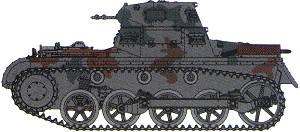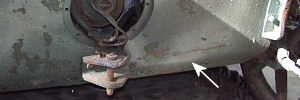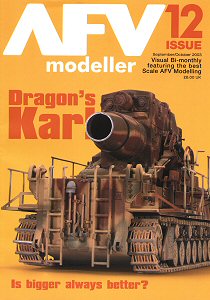

Pz.Kpfw.I Ausf.A
Early Production
Dragon Kit No. 6289
1:35th Scale
Review by Terry Ashley




Dimensional the kit measures up very well against 1:35 plans in the Achtung Panzer, Ground Power and Panzer Tracks books except for the idlers which we’ll get to shortly but for the purist the kit has a mix of pre-war 2.Series/La.S. and 3.Series/La.S features with a bit of work required to make either type accurately.
The kit is labelled “Early Production” and has the 2.Series/La.S
features of the right rear superstructure vision port and no bolted side superstructure
reinforcing strips but has the 3.Series/La.S tail light and road wheels. The
2.Series road wheels only had the reinforcing ribs on the first wheel each
side with the other three without the ribs while the kit wheels have the ribs
on all wheels so these would have to be modified to depict accurately.
Other features of the two fuel filler ports on the engine deck and narrow 60cm
glacis access hatch are for both the 2.Series and 3.Series vehicles.
The decal sheet has markings for two wartime 3.Series vehicles but to build either of these accurately you would have to add the bolted side superstructure reinforcing strips, eliminate the right rear side superstructure vision port and also add the armoured cowls over the rear air outlets and cover over the engine deck intake as well as adding the smoke candle racks on the rear hull for the Afrika Korps vehicle depicted.
The kit has 138 parts in light grey plastic, a further 47 in clear plastic plus a small etched fret, small decal sheet as well as a bag of individual “magic tracks” and the instruction sheet.

Sprues A and B plus the lower hull tub are straight from the Flakpanzer 1A kit with new sprue C and D with the superstructure and turret parts plus additional clear parts for the vision ports.
The standard of moulding is again excellent with virtually no pin marks to contend with due to the now standard plastic “nodes” on the parts which will require care when removing from the finer parts but are worth the effort for the blemish free parts.
Lower hull:
This is a conventional tub with separate front and rear panels with panel and
bolt head details on the bottom plate as well as axle and return roller mountings
on the hull sides.
The separate front panel has the final drive housing contours correct as well as the lower bolt heads and the underside weld seams on the final drive housings while the rear panel features a curved lower profile. While this curve is on the actual panel it is more rounded than the actual curve which is a little sharper than depicted but as this very subtle and not easily seen on the finished kit is probably not worth worrying about.


On the real panel are the 3.Series style tail light and the towing pintle plus the wooden jack block rack while at the front the glacis plate is a separate part with the 60cm inspection hatch also a separate part with additional towing hooks and the central two part headlight and right side horn which is hollowed out with slide moulds.
Suspension:
As mentioned this is from the Flakpanzer I kit and the drive sprockets have
the smaller drive teeth and rim bolts on both sides of the sprocket while
the road wheels have the reinforcing ribs on all four wheels and the wheel
cut-out profile should be more rounded at the outer edges and also the first
road wheel hub cap is slightly the wrong profile with the small notches around
the hub missing but these are shown on the other road wheels. As mentioned
above the rear three road wheels on the early 2.Series should not have the
reinforcing ribs and it’s relatively easy to trim these off if you
wish to correct this?
The rear idlers as with the Flakpanzer IA and are made up of three parts each, the main wheel and two inserts that form the inner rim lip which looks very good on the assembled wheels. Unfortunately the idler wheels are 1mm oversized in diameter when compared to the 1:35 plans on the Achtung Panzer, Ground Power and Panzer Tracks books.
The axle bogies and springs are nicely done with well defined details but with fairly prominent mould seams to be removed which is easy enough with the return roller hubs also nicely depicted details.
Assembly of the suspension is very easy and precise with the fit of the parts actually holding the bogie units together without glue but of course you would glue them in place on the kit.
Tracks:
These are all individual link “Magic Track” that don’t require
any cleanup which is a bonus over the conventional individual link track in
the Flakpanzer kit and they also have finer details especially on the end pins
but again being very small will require some patience to assemble but the end
result gives a better impression than the Flakpanzer tracks.
While they are individual links they are not workable and have to be glued together and its best to use thin tube glue and assemble a short section and allow the glue to “go off” and then fit around the drive sprocket and idler and get the right track sag before leaving them to dry completely. This is more fiddley than actual working tracks and you have to get the track sag right before the glue sets but not having any cleanup shortens the assembly time.

Fenders:
The two main fenders are separate parts with fine tread plate pattern on the
top with a single bolted strip on the undersides and you have to open up the
applicable locating holes for the tools, exhaust and other details. At the
front are two small inside fender fillets that will need care fitting as the
location is not that precise and these govern where the main fenders are located.
There are separate front and rear fender sections with fine attachments with additional small wing nuts added and the two small fender lights while the tools have moulded on tool clips and the early type D jack has the wire cutters mounted on the side which is a 3.Series feature.
The rear exhausts are in two parts with additional etched heat guards that are best annealed by running through a candle flame to make curving them to shape easier. These guards have additional fine etched mountings fitted on the inside with the small “feet” bent inwards for mounting on the fenders. The ends of the fishtail exhaust pipes are hollowed out slightly for a nice impression and the pipes out from the engine compartment have good texturing.
Superstructure:
The upper superstructure has the forward panel with nicely represented flush
screws and weld seam with the main superstructure being an inner shell with
separate front, side, top and rear panels with cut-outs for the vision ports
and hatches included.
Having all these panels separate allows for the weld seams and flush screws around the visor openings to be depicted with excellent definition and the turret ring with flush screws and inner traverse teeth is also included although the turret completely hides this after assembly it’s nice to see it there. There is also a subtle orange peel effect on the panel surfaces which helps with the overall impression.
The fit of all the panels to the inner shell and to each other is excellent not requiring any trimming or filler, any minor gaps were small enough to the dealt with by squeezing them together while gluing.
The two part side crew hatch has inner detail without any pin marks but there is no interior at all apart from the clear plastic vision port frames so you may want to leave the hatches closed in any case.
The fit of the superstructure to the lower hull was very good but there may some trimming required at the front of the glacis lower front plate join as this wasn’t the best on my kit.
Engine Deck:
The deck has separate engine inspection hatches, fuel filler caps and rear
intake hatch for good definition although there is no interior but will be
helpful if you want to add an aftermarket engine.
The details on the deck and separate hatches is very good, another reason to mould these separately and there are additional etched screens for the two rear air outlets.
A little minor trimming was required at the back of the deck to fit between the fenders but other than that this also fitted well to the lower hull and superstructure.
Turret:
This has the upper shell and lower turret ring with separate vision ports and
top hatch with subtle but nicely rendered weld seams and flush screws on
the turret shell which should come up well with careful painting and the
hatch has details on both sides with three very fine plastic latches for
the inside which will need care fitting. There is also a subtle orange peel effect
on the turret surfaces which again helps with the overall impression.
The two M.G.13k machine guns have nicely rendered cooling jackets holes but you may want to drill out the muzzles for a better look with the three part gun mounting also having nice details and will allow the guns to elevate after assembly.
There is no turret interior to speak of other than the clear plastic vision port frames which allow you to position the visors open if you wish and a large featureless seat to stand a Commander figure on if you want to add one.
Decals:
The small well printed sheet has markings for three Panzer Is but as mentioned
two are for wartime 3.Series vehicles and can’t be used with modifying
the kit with the additional wartime details as above.




The instructions are the usual exploded view line drawings that are quite busy in some places but are mostly east to follow.
Conclusion:
Another nice little kit from Dragon with some very good details
included such as the weld seam and flush screw details and suspension with
good fit of parts but with a mix of vehicle types to frustrate the purist and
a couple of minor issues such as the road and idler wheels but if you are not
concerned with these a very nice early production pre-war Panzer IA can be
built from the kit.
Some work will be involved if you want to build a wartime 3.Series vehicle but Dragon may very well releases another kit of this or the later 4.Series as they have a habit of stretching out a series as they have done with the 251, Panzer IV and Sd.Kfz.234 vehicles.
Highly recommended for a pre-war Panzer IA
The Sprues:
Click on thumbnails for larger view





Detail images


Close new window to return to review
|
Panzer Tracts No 1-1
Panzerkampfwagen I Kleintraktor to Ausf.B |
Panzer I |
| Pz.Kpfw.I/Pz.Kpfw.II and variants Achtung Panzer No.7 Dainippon Kaiga Co.,Ltd..  |
Ground Power Magazine Issue #071 April 2000 GALILEO Publishing Co.,Ltd.  |
| TANKS & ARMOUR: PanzerKampfwagen 1 & II Ian Allen Publishing 
|
AFV Modeller Issue 12 Excellent photo feature on the Panzer 1a  |
 for
the review kit.
for
the review kit.
Page created October 5, 2006